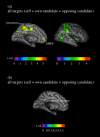Ascribing beliefs to ingroup and outgroup political candidates: neural correlates of perspective-taking, issue importance and days until the election
- PMID: 22271788
- PMCID: PMC3260850
- DOI: 10.1098/rstb.2011.0302
Ascribing beliefs to ingroup and outgroup political candidates: neural correlates of perspective-taking, issue importance and days until the election
Abstract
We used the five weeks leading up to the 2008 presidential election as a backdrop to examine the ways that the brain processes attitudes and beliefs under different circumstances. We examined individual differences in personal issue importance and trait perspective-taking, as well as the temporal context in which attitude representation took place (i.e. number of days until the election). Finally, we examined the extent to which similar or dissimilar processes were recruited when considering the attitudes of political ingroup and outgroup candidates. Brain regions involved in social cognition and theory of mind, and to a lesser extent the limbic system, were modulated by these factors. Higher issue importance led to greater recruitment of neural regions involved in social cognition, across target perspectives. Higher trait perspective-taking was also associated with greater recruitment of several regions involved in social cognition, but differed depending on target perspective; greater activity was observed in prefrontal regions associated with social cognition when considering the perspective of one's own candidate compared with the opponent, and this effect was amplified closer to the election. Taken together, these results highlight ways in which ability and motivational relevance modulate socio-affective processing of the attitudes of others.
Figures





Similar articles
-
Toward a Developmental Science of Politics.Monogr Soc Res Child Dev. 2019 Sep;84(3):7-185. doi: 10.1111/mono.12410. Monogr Soc Res Child Dev. 2019. PMID: 31503346
-
Neural correlates of maintaining one's political beliefs in the face of counterevidence.Sci Rep. 2016 Dec 23;6:39589. doi: 10.1038/srep39589. Sci Rep. 2016. PMID: 28008965 Free PMC article.
-
Us versus them: Political attitudes and party affiliation influence neural response to faces of presidential candidates.Neuropsychologia. 2007 Jan 7;45(1):55-64. doi: 10.1016/j.neuropsychologia.2006.04.024. Epub 2006 Jun 9. Neuropsychologia. 2007. PMID: 16764897
-
A neurobiological mapping of theory of mind.Brain Res Brain Res Rev. 2003 Sep;43(1):29-40. doi: 10.1016/s0165-0173(03)00190-5. Brain Res Brain Res Rev. 2003. PMID: 14499460 Review.
-
Attentional saliency and ingroup biases: From society to the brain.Soc Neurosci. 2020 Jun;15(3):324-333. doi: 10.1080/17470919.2020.1716070. Epub 2020 Jan 17. Soc Neurosci. 2020. PMID: 31928322 Review.
Cited by
-
First-Person Virtual Embodiment Modulates the Cortical Network that Encodes the Bodily Self and Its Surrounding Space during the Experience of Domestic Violence.eNeuro. 2020 May 20;7(3):ENEURO.0263-19.2019. doi: 10.1523/ENEURO.0263-19.2019. Print 2020 May/Jun. eNeuro. 2020. PMID: 32312823 Free PMC article.
-
Is social categorization based on relational ingroup/outgroup opposition? A meta-analysis.Soc Cogn Affect Neurosci. 2013 Dec;8(8):870-7. doi: 10.1093/scan/nss085. Epub 2012 Jul 30. Soc Cogn Affect Neurosci. 2013. PMID: 22847948 Free PMC article.
-
Sharing pain and relief: neural correlates of physicians during treatment of patients.Mol Psychiatry. 2014 Mar;19(3):392-8. doi: 10.1038/mp.2012.195. Epub 2013 Jan 29. Mol Psychiatry. 2014. PMID: 23358155 Free PMC article.
-
The biology of cultural conflict.Philos Trans R Soc Lond B Biol Sci. 2012 Mar 5;367(1589):633-9. doi: 10.1098/rstb.2011.0307. Philos Trans R Soc Lond B Biol Sci. 2012. PMID: 22271779 Free PMC article.
-
Intergroup bias in punishing behaviors of adults with autism spectrum disorder.Front Psychiatry. 2022 Aug 19;13:884529. doi: 10.3389/fpsyt.2022.884529. eCollection 2022. Front Psychiatry. 2022. PMID: 36061271 Free PMC article.
References
-
- Cain Miller C. 2008. How Obama's internet campaign changed politics. The New York Times, 7 November 2008 See http://bits.blogs.nytimes.com/2008/11/07/how-obamas-internet-campaign-ch...
-
- Albarracin D., Johnson B. T., Zanna M. P. (eds) 2005. The handbook of attitudes. Mahwah, NJ: Lawrence Erlbaum
-
- Cunningham W. A., Johnson M. K., Gatenby J. C., Gore J. C., Banaji M. R. 2003. Neural components of social evaluation. J. Pers. Soc. Psychol. 85, 639–64910.1037/0022-3514.85.4.639 (doi:10.1037/0022-3514.85.4.639) - DOI - DOI - PubMed
-
- Harris S., Sheth S. A., Cohen M. S. 2008. Functional neuroimaging of belief, disbelief, and uncertainty. Ann. Neurol. 63, 141–14710.1002/ana.21301 (doi:10.1002/ana.21301) - DOI - DOI - PubMed
-
- Frith U., Frith C. D. 2003. Development and neurophysiology of mentalizing. Phil. Trans. R. Soc. Lond. B 358, 459–47310.1098/rstb.2002.1218 (doi:10.1098/rstb.2002.1218) - DOI - DOI - PMC - PubMed
Publication types
MeSH terms
LinkOut - more resources
Full Text Sources

